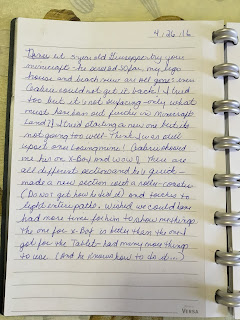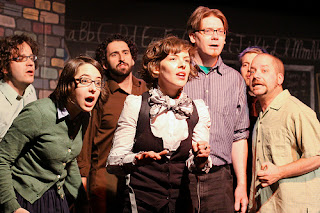From the initial steps on
my laptop, there was trouble; Amazon would not send the game to my computer but
promised it would appear instantly on my Amazon Fire. That happened to be
buried in my closet as nobody was using it including me. It was a lovely gift
from work, all set up and ready to go but completely dead. I resurrected the
poor tablet and put it on the charger, confused as to why they couldn’t simply
send it to my laptop. It all made sense later when I realized I was buying the “pocket”
edition, made for phone or tablet (duh). Once up and running, I tried a
practice game offered by Amazon, “Sidewalk Surfer” (my very first online game).
I was horrible, but someone had a lower score so I felt redeemed. Until I
realized they might be very small children. Discomfort returned; next I could
not get off the page, but finally did. Good grief!
A few days later, I began
to explore Minecraft online; I wanted to understand what it was about before I
tried it on the tablet. This helped me feel a little more in control and I
enjoyed learning about this amazing phenomenon. A sandbox game is fine by me—I
am a beach lover.
Placing and breaking blocks is also fine—until I actually tried
it myself. One needs to be very careful where they place the blocks they choose
to use. I gained lots of basic information from their site and hoped to find
the actual demo; it never downloaded so I watched all the shorter clips and
took notes (yup, I am a nerd) so I could have a clue when I began the game. But
do let me share the game history!
Markus "Notch" Persson
It was created in 2009 by a Swedish
programmer and gamer named Markus “Notch” Persson, with co-founders Jakob
Porser and Carl Manneh. Working with the company Mojang, in late 2010, they
developed the game further and in 2014, Mojang was picked up by Microsoft.
Markus and his pals are doing alright. The game itself is “procedurally
generated” and as a player you can focus on gathering resources, building your
lego-type fortress, crafting, decorating, or adding people and animals too.
It
all starts with “punching trees” which is actually fun to do, and necessary to
clear areas and get supplies. If you prefer risks, you might try combat instead
of creative mode. And it is all set on a sandy beach with the ocean nearby. The
world you create can be endless once you get to where you have cleared the way
and can start to play. So, throughout March, my Minecraft 101 training began
and I bothered my grandkids to show me stuff—anything! But as I begged for
help, I realized that this was just a game they played and “made it up” as they
went along—just like when my son and grandson are in Legoland, playing with the
blocks. When they are done, the next dad and son knock their creation down and use the blocks to start their own. I needed to just do it (like a Nike ad). So, I reread all my highlighted notes, and printouts to prepare to play. How ridiculous am I? But, I thought it would help, and (sort of) did--once I got things started. The Parents Guide to Minecraft did offer some level of comfort to my awkward beginning.
Realizing that I could stay in creative mode was a big step for me; the problem was getting the knack for punching trees, and then using tools to break walls. Little steps, and my notes, got me there. The procedural concept turned out to be fascinating as each new “map” or world is unique. I have three different worlds that are my crazy creations. One of them, my favorite, got lost for a while when visiting my brother in Italy. But do let me explain… After I got through the basics for starting up (punching trees, getting supplies, using picks and other tools) I learned the importance of torches. My first, and still favorite world was going to be a beachfront castle.
By other people’s standards, it is still very simple but to me it was a masterpiece. Except the one wall was too big and cumbersome—it was ugly. So, I tried to break it but it would not budge. Then I had an idea—I’d use the dynamite to bust through it! But, the dynamite would not blow. Instead, it seemed to grow, and grow, and grow. It was taking up the whole screen and none of the tools would work! Well, I needed a kid, and I knew it.
4/21/16 My brothers first
birthday party, up in Casalino, had--you guessed it--many kids so I found one
who really knew Minecraft. It was Gabrie, who I’ve known since he was a baby,
and one of the best-natured kids you could find. With his older brother Elia to
help with translations, he suggested I use the torch to light the dynamite. WOW!
Why didn’t I think of that?
The child is obviously brilliant, so I thanked him
and once back in Firenze, I pulled out the game, lit the dynamite with the
torch and it blew sky-high so fast, I couldn’t get a picture. Happily I noted that the property was not damaged, or the sheep, cow, and occasional dog (he comes and goes). At first, I had no idea where the animals came from but I evidently clicked them in when I first went into settings; I’m quite pleased as they are noisy but fun company. The days and nights come and go quickly but when you lose your way at night it can be spooky so I did add some torches to key areas for light.
4/26/16 Finally, Tuesday night arrived and with my tablet handy, off we went to dinner
at the Rossi’s. As we were sitting on the couch chatting with Fillipo and
Serena waiting for the kids to finish their homework, little Giuseppe wanted to
see my Minecraft game. Of course, I let him—I was the guest, and he is an adorable five year-old. My sister and I
watched as he quickly navigated the screen to places I’d never seen. He seemed
quite gifted. Just then, Gabrie arrived and looking dismayed, grabbed
my tablet from his brother. It seems little Giuseppe does not know how to play
and navigated so far away from my castle that we could not find it! Very sadly,
I put the tablet away. But Gabrie gave me a lesson on the one upstairs;
actually we all watched. And then I understood how much one could do with this
game. The videos on YouTube demonstrated the games potential, but this was a ten year-old kid creating amazing things in front of our eyes! I cannot make the roller coaster
he made at the end of his lesson—I don’t even know if I could on the tablet, with guidance—but
I did pick up more basics that have helped me with building and breaking
through walls; simple but necessary skills.
5/2/16 Finally,
after starting another new world, and fixing up a little on my very first one,
I found my island with my sheep and dog! At first I could not get it to the
forefront but there were animals with illuminated eyes and my lego man—the one
I couldn’t get on the screen—bobbing around in the water.
After watching Gabrie, I’ve been placing torches along walls, perimeters, and caverns for light and safety. I still cannot get the food to appear on the tables so I have food walls and doors. I see that to really master this game would take much longer, but I am content with the steps I’ve learned. Game-playing is a pleasant diversion, and kids actually have that kind of time to invest.
5/3/16 My sheep has grown and it is huge! I finally got my house back to
normal and moved the bed (enormous) as well as two crafting tables. One table is on the deck and the other on the first floor patio; I added a picture to the
wall and some more torches, but still cannot get food on the tables. The
animals seem to nibble the food walls so it’s okay. They all make happy sounds
and the sea creatures’ splash and play; perhaps I should move there and join
the fun.
The other two worlds are
nowhere near as done but the one is a cavern and quite crazy; there are many
active lego men of different colors and design; their activity is very intriguing.
The
remaining world was always raining and although I tried to do some
building it was hard to work in the rain (no kidding). I just got to revisit
that one, as the rain finally stopped but didn't build much. Instead, I cleared areas and planted some lovely tulips. After all this worrying, and major feelings of discomfort, failure and desperation just trying to master what my grandkids “pick up” from experimenting, I am quite pleased that I got this far with my limited skills. And I’d recommend it as a fun alternative to watching TV or other sedentary pastimes—when you are able to build anything you feel like you accomplished something great! And if you have kids who play they might even show you a few things…




















































